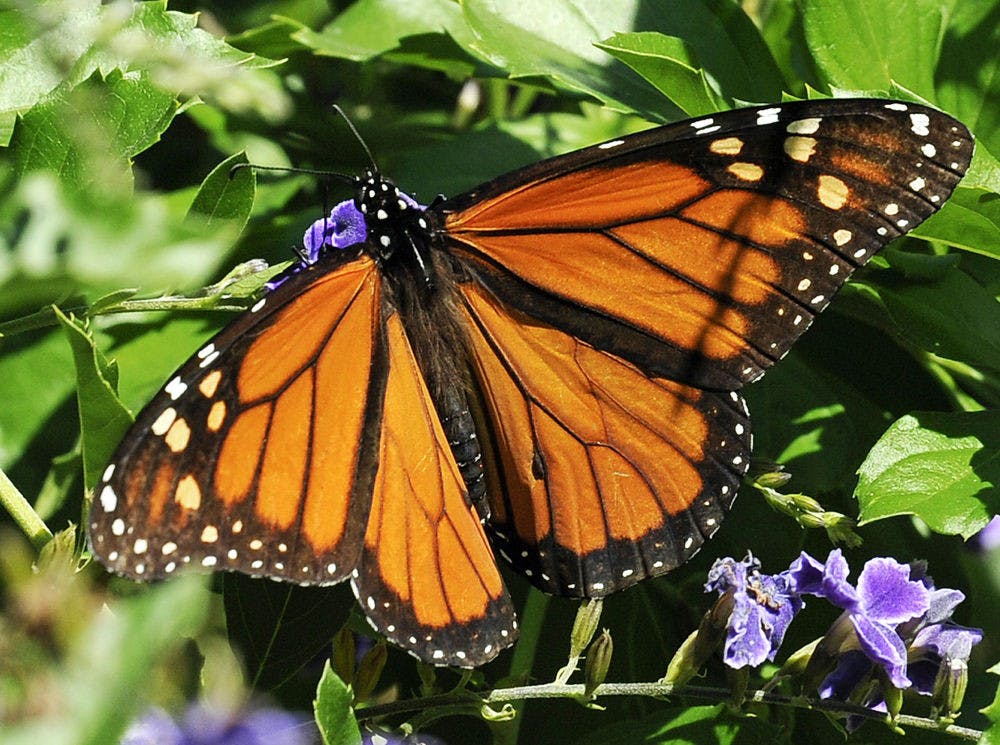Fewer orange specks are making their way across the blue sky.
Because of habitat destruction and a shortage of milkweed, monarch butterflies are disappearing.
Every year, millions of North American monarchs make a 3,500-mile migration from northern United States and Canada to California and Mexico.
At their peak population in the mid-1990s, there were more than 1 billion of the butterflies, said Thomas C. Emmel, director of the McGuire Center of Lepidoptera and Biodiversity at the Florida Museum of Natural History.
Twenty years later, their migrating population has plunged to about 30 million, Emmel said.
For Emmel, viewing millions of butterflies take flight at once is like watching “the bursting of a bomb; the explosion of fireworks off of a tree.”
Since 1981, Emmel has gone to Mexico every year to see the butterflies in their hibernating grounds.
“When they go up into the blue sky, you’re going to have a true orange and blue event: the orange monarchs against the beautiful blue sky,” he said.
In recent years, the monarchs have suffered habitat destruction in their hibernating grounds in Mexico and their larvae feeding grounds in the Midwest, Emmel said. The loss is harming their ability to reproduce.
In Mexico, two hibernating grounds were being logged for firewood, opening the forests and high mountains to winter winds and snow storms that could kill the monarchs, he said. In the Midwest, herbicides and genetically engineered crops are major contributors to the loss of the milkweed plant, the butterfly’s food source.
On Feb. 9, the U.S. Fish and Wildlife Service announced they were allocating $3.2 million to the preservation of the monarch butterfly and its habitats, Emmel said. Two million dollars will go toward paying farmers and ranchers not to use genetically modified crops and to not spray anything that would disturb the milkweed.
The other $1.2 million will be matched by both the National Fish and Wildlife Foundation and the National Wildlife Federation. These funds will be used to encourage planting milkweed in backyard and school gardens, as well as in county and city parks.
“We have the pleasure of seeing them here every summer, but we won’t see them much longer if something dramatic isn’t done,” Emmel said.
Although the help is coming from a national level, local organizations are also lending a hand.
Ryan Fessenden, assistant manager of rainforest operation at the Florida Museum, said the butterfly garden behind the museum is called a Monarch Waystation, which includes plants that support the entire monarch life cycle.
The pesticide-free gardens require milkweed for caterpillars and nectar plants for butterflies, as well as protection from the weather, predators and maintenance. The museum’s goal is to help in whatever small way it can.
“Give them a home,” Fessenden said. “Give back a little of what, essentially, we have taken.”
[A version of this story ran on page 9 on 2/17/2015 under the headline “Environmental loss causing monarch butterfly disappearance"]
Monarchs have excellent eyesight. A monarch cruising 500 feet in the air that sees milkweed below will come plummeting down.
Monarch butterfly’s size is relative to a tea cup.
Monarchs live up to six to eight months.
Distinct wing patterns warn predators that monarchs are both unappetizing and poisonous.
Information courtesy of http://animals.nationalgeographic.com/animals/bugs/monarch-butterfly/





